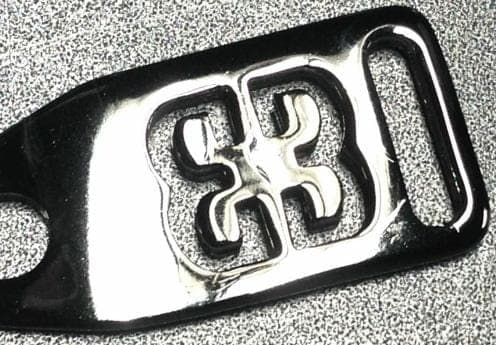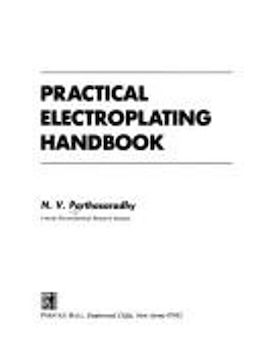
Curated with aloha by
Ted Mooney, P.E. RET

The authoritative public forum
for Metal Finishing 1989-2025

-----
Solutions to Problems with Bright Nickel Plating Baths
Stardusting
Q. Hello and thanks in advance for the help , we do mostly show quality plating for cars, motorcycles, etc. All of our nickel and chrome plating is plated over acid copper which has been buffed to a mirror finish. Because of this mirror finish, imperfections are easily seen and one that we have from time to time is a "stardust" or white speckles that show up in the nickel . These small speckles show up over the whole part except for the bottom side -- it's almost as if a white dust settles on the part during the nickel plating and we are having a hard time trying to figure out the cause and how to prevent it. Thanks for the help.
Billy Brown- Lyman, South Carolina
2001
2001
A. Billy:
This question about stardusting was asked in our forum and a electroplating chemist answered it. Here is his answer.
His problem, if he is using brighteners, could be:
1) excess brightener
2) insufficient leveler
3) insufficient carrier
4) pH too high
5) insufficient air agitation
Hope this helps!
Tom Haltmeyer- Peoria, Arizona
A. Stardusting is sometimes caused by precipitation of calcium or magnesium salts in nickel plating solutions. Check to see if hard water is used to make up evaporation losses. The fact that it settles on shelf areas indicates that this could be the problem.

Tom Pullizzi
Falls Township, Pennsylvania
2001
A. Make sure that your boric acid content is not supersaturated. You probably have boric crystals that are settling in your parts. A quick way to check is to take a sample of the bath in a beaker [beakers on eBay or Amazon [affil links] and let it cool to room temperature and if you see crystals forming fast like an hour or two then the boric is to high. To remove it simply cool your entire bath for several days with no agitation and simply scoop the boric acid from the tank bottom.
Russell Richter- Danbury, Connecticut, USA
2001
A. It is important to know how you are re-activating the copper before nickel plating. If your supplier does not find anything wrong with the nickel bath per se, it is probably in the activation/cleaning of the buffed copper. Also, this type of problem sometimes can occur due to high organics in the copper bath. A carbon treatment of the copper could solve this problem.
Gene Packmanprocess supplier - Great Neck, New York
2001
A. The fact that it is only on the top surfaces would indicate it is insolubles in the nickel tank. When the trouble occurs, take a liter and filter through a buchner filter funnel, rinse and examine the filter paper under low magnification. If iron contamination then will be brown ppt, if calcium whitish, black nickel sulfide etc. Check anode bags. Do similar check on outlet of filter to ensure there is nothing passing filter. Check air source for particulate contamination.
To check if the problem is coming from a source before the nickel, wipe one piece on a top significant surface just prior to going into the nickel and see if any difference between this and the part next to it

Geoffrey Whitelaw
- Port Melbourne, Australia
2001
A. If you feel any roughness in the areas of a "stardust" more likely you are dealing with the solids: check your bags, filtration, PH, concentration of boric acid, temperature, condition of your racks(to eliminate contamination from previous operations), conditions of your air source, especially presence of oils and solids in the air. Also it's highly recommended to make the Hull cell test to see the area of C.D. where the problem appeals. If it's on a high C.D. area repeatably, then consider a possibility of high level of organic contaminations as well and full bath chemical treatment (hydrogen peroxide, 5.5 pH, carbon)would be necessary to perform. Also pay attention on the carbon dust like a source of organics and roughness from solids, so make sure the mesh of your filter cartridge is correct to halt any solids (I'm using 1 mkm).
Vlad Neyshtadt- Fountain Valley, California
2001
A. First I would recommend to improve filtration. If the problem is mainly on the "shelves" it is probably a result of poor filtration. The second parameter is the quality of the water used in the plating solution and in the rinses.

Sara Michaeli
Tel-Aviv-Yafo, Israel
2001
Bright Nickel Plating Turns Gray the Next Day
Q. Hello Everyone, this is my first post here and I really hope you guys can help me.
I have a problem with the bright nickel deposition, you can see the picture here:

What do you think it is?
Enrique Guillen- Guatemala
May 19, 2014
May 2014
A. Hi Enrique. The picture probably helps to confirm the problem you have in mind, but what you are finding unsatisfactory is not as obvious as you might think :-)
Are you the customer or are you from the plating shop? How big is the part, maybe 1" x 2"? What is it made of, cast brass? It's hard to judge/guess what you consider bad about this part based only on a low resolution photo --
1. There are several scratches.
2. There looks to be a grainy unpolished area near the lower right.
3. There may be blistering but I can't tell.
4. Photos can be deceiving but it looks like the part wants quite a bit more vibratory finishing before plating.
Tell us more.
Regards,

Ted Mooney, P.E.
Striving to live Aloha
finishing.com - Pine Beach, New Jersey
Q. Hello Ted, thanks for your reply
This is a zinc piece, about 1 inch tall, we hand polished it very nicely.
Cleaned it, alkaline copper and acid copper, everything looked great at that point, so we applied nickel to the piece and it looked good, but in the center of the piece, there were some steps, like the nickel was not deposited well on those parts. They were close to the wire and most of them have the problem in the back side of the piece, where it had little contact with the wire, but some looked bad on the front too.
After a day the piece started to look gray on those parts.
Thank you for your help!
- Guatemala
May 23, 2014
A. Hi Enrique. If the volume supports it, the parts ought to be plated on proper plating racks rather than simply wired. The best bright nickel plating requires a current of about 40 amps per square foot, and it can be difficult to get consistent bright nickel on parts that are flopping around on wire such that the current density varies; and small gauge wire may be limiting it as well.
I don't have enough experience to guess why the parts are discoloring a day later unless the nickel plating is just very thin in those areas for the reasons I mentioned. Good luck.
Regards,

Ted Mooney, P.E.
Striving to live Aloha
finishing.com - Pine Beach, New Jersey
May 2014
May 29, 2014
A. Good day Enrique.
It might be a number of conditions which are responsible for the nickel plating darkness/thin deposit which turns grey.
Firstly, check for metallics, as they show up in the LCD area.
A quick fix/check would be to dummy plate at LCD 2-5 ASF overnight. Copper can cause LCD darkness.
Check bath concentrations and pH, making sure they are in operating parameters.
Excess brightener/insufficient carrier also causes poor/dark LCD coverage.
Organics can also cause dark LCD. Try carbon on your filters, but remember carbon removes brightener and wetting agent.
Try a hull cell panel to determine the solution after trying the above possibilities.
Hope this was helpful.
Regards,
Aerotek Mfg. Ltd. - Whitby, Ontario, Canada
Bright nickel stardusting
Q. Hello All,
First post so bear with me. I am just looking for a definition of stardusting (not pitting or particulate roughness or precipitation). What is it? I have heard a myriad of definitions and no one seems to have any sort of definition just an idea.
We have some highly polished parts we are observing the stardusting on. It is not part specific, cleaner/prep problem, or particulates, as I have been able to replicate on zincated steel panels which just get a muriatic dip and then plate. We also bend some panels to observe if shelf roughness, which it appears all over (including underside) so it's not particulates. It is also not "micropitting" as it does not show up predominately in gassing areas. Again, it is an all over uniform stardusting pattern. I can replicate it on a hull cell as well.
The reason I ask is because I am stumped. I got three reasons from my supplier: 1. excess brightener (tried Carbon treating on lab scale and observed no improvement, didn't even lose brightness), 2. low carrier (I've tested this on hull cell as well to no avail), or some form of saying it's precipitates (high pH or supersaturated boric etc).
My suspicion is its organics but something went wrong with my batch carbon treatment (it clearly didn't take brightener out). I have confirmed our carrier to be at optimum value. Our TOC's are at 7700 ppm but they usually hover around there and we've had more but this is my best guess.
Would anyone have any suggestions, or more importantly, a definition of "stardusting" so I can understand what I am combating?
process engineer - Dayton, Ohio, United States of America
March 5, 2018
A. Hi Kevin. The general idea of "star dusting", as you'll read on this thread, is micro-roughness due to deposits of tiny particles rather than pitting; so I'd agree with you at least that far. I wouldn't want to discourage anyone from trying to more precisely define it for you, but I think all you can really get is this "general idea" because when something starts out from slang it rarely gets more precise as it's bandied about in thousands of locations around the world. For example, Parthasaradhy .
claims it is peculiar to plating on plastics, but others certainly disagree.
I see the term used in at least 6 other threads on this site, and if you review them you'll see that some knowledgeable people may consider "shelf roughness" as stardusting whereas others agree with you that it might look like what shelf roughness looks like, but if you have shelf roughness, that's not stardusting :-)
Can you try a Hull Cell at a slightly higher or lower temperature to see if precipitation of supersaturated boric acid or other salts is less problematic at higher temperatures? -- not to solve the problem, but perhaps to indicate that it is an oversaturation problem? Did you try an elevated temperature carbon treatment, or just run the solution through carbon at 140 °F? Good luck. Hopefully someone who actually has experience rather than just book knowledge will chime in :-)
Regards,

Ted Mooney, P.E. RET
Striving to live Aloha
finishing.com - Pine Beach, New Jersey
March 2018
March 29, 2018
A. Lyman,
STAR DUST PROBLEM
1) Check the part, it is roughness or pit
pits-- check surface tension of your nickel tank, maybe you need to be add wetter.
2) Check if your filter is plugged up or blew filter powder into the tank; clean the filter and repack.
3) Check anode basket bags, may be ripped, change the bags.
4) Check your incoming parts -- may be poor metal -- pits on part before you plate or parts are not cleaned good (compound left on part).
5) Parts fell in the tank so long -- pull out parts from the tank & clean the tank

Popatbhai B. Patel
electroplating consultant - Roseville, Michigan
White precipitate on anode rods & anode bags in Nickel sulphate solution
Q. I am employed in one of the manufacturing line for electronic components, and one of my concern is the white precipitate forming in the anode bag and on the top of anode that is exposed in air. All of the plating solution parameters are in specs (pH, Ni metal conc., H3BO3 conc., etc.) What could this be? and what phenomenon do you call this? I'm bothered because in other baths that uses Ni sulfamate, no precipitation was observed.
Kim Bernatengineer - Philippines
July 22, 2018
A. Your Boric Acid concentration is too high for the temperature that you are running, and in air when the solution evaps, well, boric acid is white.

Robert H Probert
Robert H Probert Technical Services
Garner, North Carolina

July 23, 2018
Q, A, or Comment on THIS thread -or- Start a NEW Thread
